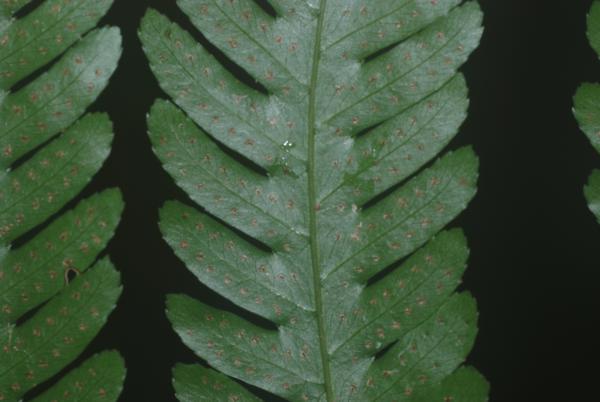
Pteridrys syrmatica (Willd.) C.Chr. & Ching
Family
Tectariaceae
Nomenclature
Pteridrys syrmatica (Willd.) C.Chr. & Ching, Bull. Fan Mem. Inst. Biol. 5 131, pl. 11, 17. 1934; Tardieu & C.Chr., Fl. Indo-Chine 7(2): 302. 1941; Holttum, Rev. Fl. Malaya ed. 1, 2: 530, f. 311 & 312. 1955 [‘1954’]; Seidenf., Nat. Hist. Bull. Siam Soc. 19: 87. 1958; Tagawa & K.Iwats., SouthE. Asian Stud. 3(3): 86. 1965; Tagawa & K.Iwats., SouthE. Asian Stud. 5: 100. 1967; Tagawa & K.Iwats., Fl. Thailand 3: 388. 1988; Holttum, Fl. Males., Ser. II, Pterid. 2: 5, f. 1. 1991; Boonkerd & Pollawatn, Pterid. Thailand: 210. 2000. – Aspidium syrmaticum Willd., Sp Pl. 5: 237. 1810. – Lastrea syrmatica (Willd.) T.Moore, Index Filic.: 105. 1858; Bedd., Handb. Ferns Brit. India: 243, f. 124. 1883; E.Smith, J. Siam Soc. Nat. Hist. Suppl. 8: 5. 1929. – Type: "Habitat in Peru, Chile" (B, herb Willd. 19765).
Description
Rhizome short, creeping or ascending; scales lanceolate, rounded or cordate at base, tailed at apex, up to 8 by 1.2 mm, dark brown, rather thick hairy at margin. Stipes up to 50 cm long, stramineous to pale castaneous, scaly at base, glabrescent above. Laminae oblong to oblong-lanceolate, pinnate with deeply lobed pinnae, 30–50 by 15–30 cm; rachis glabrescent, pale stramineous to deep brown; lateral pinnae 5–12 pairs, ascending, petioles of basal pinnae 1–1.5 cm long, lanceolate, subtruncate to broadly cuneate at base, up to 20 by 4 cm, deeply lobed to 4/5 way towards costule; lobes oblong, oblique, rounded at apex, serrate at margin, up to 17 by 7 mm; papyraceous, deep green, glabrous; costules pale, glabrous, raised on both surfaces; veins pinnate, the basal basiscopic veinlets springing directly from costa, veinlets forked, acroscopic branches ending midway, basiscopic branches running into the projections at margin, and a branch into sinus-teeth. Sori apical or subapical at acroscopic branches of veinlets, thus medial, round; indusia round to elongate reniform, glabrous .
Distribution in Thailand
NORTHERN: Chiang Mai; SOUTH-WESTERN: Phetchaburi, Prachuap Khiri Khan; PENINSULAR: Surat Thani, Phangnga, Krabi, Nakhon Si Thammarat, Trang, Satun, Yala.
Wider Distribution
Sri Lanka, S Vietnam and Malesia, east to Sulawesi and the Philippines.
Ecology
On humus-rich ground in dense evergreen forests at altitudes lower than 600 m.
Proposed IUCN Conservation Assessment
Least Concern (LC). This species is widespread and not under any known threat.
Voucher specimens - Thailand
Middleton et al. 4286, Surat Thani, Khao Photha Daeng Lam (E).
Site hosted by the Royal Botanic Garden Edinburgh. Content managed by Stuart Lindsay, Gardens by the Bay, Singapore and David Middleton, Singapore Botanic Gardens. Last updated 24 January 2012
